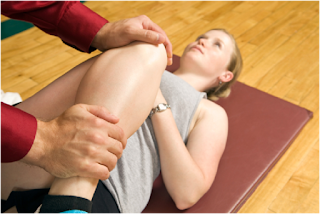On Saturday
February 9th, TOCA Physical Therapist Christine Phillips will be
participating in the Sun Devil Classic
(Strada Racing Club & ASU Cycling) road cycling event in Tempe from 7am to
5pm. (Click
here to read more about this event). I deemed that this would be a good
opportunity to talk about cycling and common injuries. Whether you ride a road,
mountain, commuter or cruiser bike, cyclists are susceptible to a wide variety
of injuries. These injuries can be related to many factors including muscle
weakness, muscle tightness, improper fitting to your bike, poor pedaling
mechanics or improper training. Many of these injuries can be avoided by adding
several simple exercises and stretches to your weekly routine.
Today,
there are about 80 million cyclists in the United States. Studies estimate that
large numbers of these cyclists experience physical problems: 48 percent in
their necks, 42 percent in their knees, 36 percent in the groin and buttocks,
31 percent in their hands, and 30 percent in the back.
Knee Pain
The
knee is the most common site for overuse injuries in cycling. Patellofemoral
syndrome (cyclist's knee), patella and quadricep tendinitis, medial plica
syndrome, and iliotibial band friction syndrome are a few of the more common
knee overuse injuries. The first four injuries mentioned involve pain around
the kneecap, while the last condition results in outer knee pain. Shoe
implants, wedges beneath the shoes, and cleat positions may help prevent some
overuse injuries.
Head Injuries
One of
the most common injuries suffered by cyclists is a head injury, which can be anything
from a cut on the cheek to traumatic brain injury. Wearing a helmet may reduce
the risk for head injury by 85 percent. The majority of states have no laws
governing the use of helmets while riding a bicycle, but helmets are readily
available for purchase and typically low in cost.
Neck/Back Pain
Cyclists
most likely experience pain in the neck when they stay in one riding position
for too long. An easy way to avoid this pain is by doing shoulder shrugs and
neck stretches that help relieve neck tension. Improper form also leads to
injuries. If the handlebars are too low, cyclists may have to round their
backs, thus putting strain on the neck and back. Tight hamstrings and/or hip
flexor muscles can also cause cyclists to round or arch the back, which causes
the neck to hyperextend. Stretching these muscles on a regular basis will
create flexibility and make it easier to maintain proper form. Changing the
grip on the handlebars takes the stress off of over-used muscles and
redistributes pressure to different nerves.
Wrist/Forearm Pain or Numbness
Cyclists
should ride with their elbows slightly bent (never with their arms locked or
straight). When they hit bumps in the road, bent elbows will act as shock
absorbers. This is also where changing hand positions will help reduce pain or
numbness. Two common wrist overuse injuries, Cyclist's Palsy and Carpal Tunnel
Syndrome, can be prevented by alternating the pressure from the inside to the
outsides of the palms and making sure wrists do not drop below the handlebars.
In addition, padded gloves and stretching the hands and wrists before riding
will help.
Foot Numbness and Tingling
Foot
numbness and tingling are common complaints, and shoes that are too tight or
narrow are often the cause. In addition, foot numbness can be due to exertional
compartment syndrome. This arises from increased pressure in the lower leg and
resulting compression of nerves. The diagnosis is made by pressure measurements
and is treated with surgical release.
General
injury types
- Tendinitis
- inflammation or irritation of a tendon can be caused by different
reasons ie. ill-fitting shoe or cleat position. Falls may also cause
bruising to tendons and overuse or extra or sudden forces may cause
strains. Pain can arise from nerve irritation within the tendon and must
be taken as a warning that something is wrong, the tendon maybe swollen or
stretched or small tears may have occurred. Many overuse injuries around
the knee are overuse tendon injuries.
- Bursitis
- irritation or inflammation of the fluid filled cystic structures found
between surfaces that facilitate movement over each other. When one of
those surfaces is also tendon then it is difficult to distinguish between
tendinitis and bursitis. This is of little relevance because the treatment
regime is the same for both.
- Compression neuropathy - an abnormality of nerve function often caused by
pressure on a nerve or the blood vessels that supply it. The common
cycling neuropathies are cyclist's palsy (ulnar nerve) and penile
numbness, a common problem related to the abnormal function of the
pudendal nerve.
- Stress fracture - an overuse injury of bone which are relatively uncommon in cycling.





